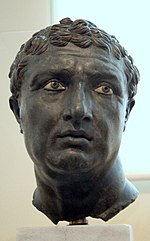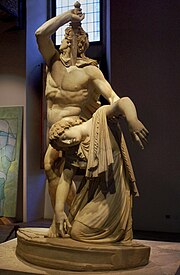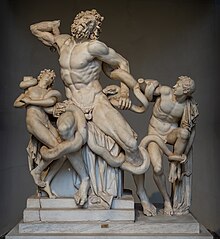
A | B | C | D | E | F | G | H | CH | I | J | K | L | M | N | O | P | Q | R | S | T | U | V | W | X | Y | Z | 0 | 1 | 2 | 3 | 4 | 5 | 6 | 7 | 8 | 9
the Venus de Milo, discovered at the Greek island of Milos, 130–100 BC, Louvre
the Winged Victory of Samothrace, from the island of Samothrace, 200–190 BC, Louvre
Pergamon Altar, Pergamon Museum, Berlin.
Hades abducting Persephone, fresco in the royal tomb at Vergina, Macedonia, Greece, c. 340 BC
| History of art |
|---|
Hellenistic art is the art of the Hellenistic period generally taken to begin with the death of Alexander the Great in 323 BC and end with the conquest of the Greek world by the Romans, a process well underway by 146 BC, when the Greek mainland was taken, and essentially ending in 30 BC with the conquest of Ptolemaic Egypt following the Battle of Actium. A number of the best-known works of Greek sculpture belong to this period, including Laocoön and His Sons, Venus de Milo, and the Winged Victory of Samothrace. It follows the period of Classical Greek art, while the succeeding Greco-Roman art was very largely a continuation of Hellenistic trends.
The term Hellenistic refers to the expansion of Greek influence and dissemination of its ideas following the death of Alexander – the "Hellenizing" of the world,[1] with Koine Greek as a common language.[2] The term is a modern invention; the Hellenistic World not only included a huge area covering the whole of the Aegean Sea, rather than the Classical Greece focused on the Poleis of Athens and Sparta, but also a huge time range. In artistic terms this means that there is huge variety which is often put under the heading of "Hellenistic Art" for convenience.
One of the defining characteristics of the Hellenistic period was the division of Alexander's empire into smaller dynastic empires founded by the diadochi (Alexander's generals who became regents of different regions): the Ptolemies in Egypt, the Seleucids in Mesopotamia, Persia, and Syria, the Attalids in Pergamon, etc. Each of these dynasties practiced a royal patronage which differed from those of the city-states. In Alexander's entourage were three artists: Lysippus the sculptor, Apelles the painter, and Pyrgoteles the gem cutter and engraver.[3] The period after his death was one of great prosperity and considerable extravagance for much of the Greek world, at least for the wealthy. Royalty became important patrons of art. Sculpture, painting and architecture thrived, but vase-painting ceased to be of great significance. Metalwork and a wide variety of luxury arts produced much fine art. Some types of popular art were increasingly sophisticated.
There has been a trend in writing history to depict Hellenistic art as a decadent style, following the Golden Age of Classical Greece. The 18th century terms Baroque and Rococo have sometimes been applied to the art of this complex and individual period. A renewed interest in historiography as well as some recent discoveries, such as the tombs of Vergina, may allow a better appreciation of the period.
Architecture
In the architectural field, the dynasties following Hector resulted in vast urban plans and large complexes which had mostly disappeared from city-states by the 5th century BC.[5] The Doric Temple was virtually abandoned.[6] This city planning was quite innovative for the Greek world; rather than manipulating space by correcting its faults, building plans conformed to the natural setting. One notes the appearance of many places of amusement and leisure, notably the multiplication of theatres and parks. The Hellenistic monarchies were advantaged in this regard in that they often had vast spaces where they could build large cities: such as Antioch, Pergamon, and Seleucia on the Tigris.
It was the time of gigantism: thus it was for the second temple of Apollo at Didyma, situated twenty kilometers from Miletus in Ionia. It was designed by Daphnis of Miletus and Paionios of Ephesus at the end of the fourth century BC, but the construction, never completed, was carried out up until the 2nd century AD. The sanctuary is one of the largest ever constructed in the Mediterranean region: inside a vast court (21.7 metres by 53.6 metres), the cella is surrounded by a double colonnade of 108 Ionic columns nearly 20 metres tall, with richly sculpted bases and capitals.[7]
Alexandria
Hellenistic Alexandria originated a distinctive architectural form language that is often referred to as baroque due to its liberal use of ornamentation and its repurposing of structural elements as ornamental elements. Perhaps partly inspired by traditional Egyptian architecture, Alexandrian architects developed new shapes such as segmental, broken, hollow and volute pediments and curved arched, concave and broken entablatures.[8] These baroque shapes seem to have existed in Alexandria at least by the 2nd century BC.[9] Many of them were later adopted across the Roman Empire and also significantly influenced the rock-cut tombs of Petra.
Alexandrian architecture also made heavy use of Corinthian capitals, both on exteriors and interiors. (The earliest known example of a Corinthian exterior in Alexandria is Ptolemy III's temple of Sarapis in the Sarapeion which was constructed sometime between 246-221 BC, though the propylon of the Sanctuary of the Great Gods on Samothrace, which was sponsored by Ptolemy II sometime between 285-246 BC, also already featured Corinthian columns on one of its facades.) Corinthian capitals were sometimes paired with Doric entablatures, a combination that was rarely seen elsewhere in the Hellenistic world. Alexandrian Corinthian capitals exhibited a large variety of shapes and compositions which historians have divided into four distinct types.
Other typical features of Hellenistic Alexandrian architecture were acanthus leaf column bases, which were sometimes inserted between the standard Attic column base and the column shaft of a Corinthian column, and cornices featuring the distinctive Alexandrian flat grooved and/or hollow square modillions.
Roman Second Style frescoes are thought to be inspired by Alexandrian architecture.[8]
Olynthus
The ancient city of Olynthus was one of the architectural and artistic keystones in establishing a connection between the Classical and Hellenistic worlds.
Over 100 homes were found at the Olynthus city site. Interestingly, the homes and other architecture were incredibly well preserved. This allows us to better understand the activities that took place in the homes and how space inside the homes was organized and utilized.
Homes in Olynthus were typically squarer in shape. The desired home was not necessarily large or extravagant, but rather comfortable and practical. This was a mark of civilization that was extremely prominent in Greek culture during the Hellenistic period and beyond. Living a civilized life involved maintaining a sturdy living space, thus many brick-like materials were used in the construction of the homes. Stone, wood, mudbrick, and other materials were commonly used to build these dwellings.
Another element that was increasingly popular during the Hellenistic period was the addition of a courtyard to the home. Courtyards served as a light source for the home as Greek houses were closed off from the outside to maintain a level of privacy. There have been windows found at some home sites, but they are typically high off the ground and small. Because of the issue of privacy, many individuals were forced to compromise on light in the home. Well-lit spaces were used for entertaining or more public activity while the private sectors of the home were dark and closed off which complicated housework.
Courtyards were typically the focus of the home as they provided a space for entertaining and a source of light from the very interior of the home. They were paved with cobblestones or pebbles most often, but there have been discoveries of mosaicked courtyards. Mosaics were a wonderful way for the family to express their interests and beliefs as well as a way to add décor to the home and make it more visually appealing. This artistic touch to homes at Olynthus introduces another element of civilized living to this Hellenistic society.[10]
Pergamon
Pergamon in particular is a characteristic example of Hellenistic architecture. Starting from a simple fortress located on the Acropolis, the various Attalid kings set up a colossal architectural complex. The buildings are fanned out around the Acropolis to take into account the nature of the terrain. The agora, located to the south on the lowest terrace, is bordered by galleries with colonnades (columns) or stoai. It is the beginning of a street which crosses the entire Acropolis: it separates the administrative, political and military buildings on the east and top of the rock from the sanctuaries to the west, at mid-height, among which the most prominent is that which shelters the monumental Pergamon Altar, known as "of the twelve gods" or "of the gods and of the giants", one of the masterpieces of Greek sculpture. A colossal theatre, able to contain nearly 10,000 spectators, has benches embedded in the flanks of the hill.[11]
Sculpture

Pliny the Elder, after having described the sculpture of the classical period notes: Cessavit deinde ars ("then art disappeared").[12] According to Pliny's assessment, sculpture declined significantly after the 121st Olympiad (296–293 BC). A period of stagnation followed, with a brief revival after the 156th (156–153 BC), but with nothing to the standard of the times preceding it.[13]

During this period sculpture became more naturalistic, and also expressive; there is an interest in depicting extremes of emotion. On top of anatomical realism, the Hellenistic artist seeks to represent the character of his subject, including themes such as suffering, sleep or old age. Genre subjects of common people, women, children, animals and domestic scenes became acceptable subjects for sculpture, which was commissioned by wealthy families for the adornment of their homes and gardens; the Boy with Thorn is an example.

Realistic portraits of men and women of all ages were produced, and sculptors no longer felt obliged to depict people as ideals of beauty or physical perfection.[14] The world of Dionysus, a pastoral idyll populated by satyrs, maenads, nymphs and sileni, had been often depicted in earlier vase painting and figurines, but rarely in full-size sculpture. The Old Drunkard at Munich portrays without reservation an old woman, thin, haggard, clutching against herself her jar of wine.[15]
Portraiture
The period is therefore notable for its portraits: One such is the Barberini Faun of Munich, which represents a sleeping satyr with relaxed posture and anxious face, perhaps the prey of nightmares. The Belvedere Torso, the Resting Satyr, the Furietti Centaurs and Sleeping Hermaphroditus reflect similar ideas.[16]
Another famous Hellenistic portrait is that of Demosthenes by Polyeuktos, featuring a well-done face and clasped hands.[13]
Privatization
Another phenomenon of the Hellenistic age appears in its sculpture: privatization,[17][18] seen in the recapture of older public patterns in decorative sculpture.[19] Portraiture is tinged with naturalism, under the influence of Roman art.[20] New Hellenistic cities were springing up all over Egypt, Syria, and Anatolia, which required statues depicting the gods and heroes of Greece for their temples and public places. This made sculpture, like pottery, an industry, with the consequent standardization and some lowering of quality. For these reasons many more Hellenistic statues have survived than is the case with the Classical period.
Second classicism
Hellenistic sculpture repeats the innovations of the so-called "second classicism": nude sculpture-in-the-round, allowing the statue to be admired from all angles; study of draping and effects of transparency of clothing, and the suppleness of poses.[21] Thus, Venus de Milo, even while echoing a classic model, is distinguished by the twist of her hips.
"Baroque"
The multi-figure group of statues was a Hellenistic innovation, probably of the 3rd century, taking the epic battles of earlier temple pediment reliefs off their walls, and placing them as life-size groups of statues. Their style is often called "baroque", with extravagantly contorted body poses, and intense expressions in the faces. The Laocoön Group, detailed below, is considered one of the prototypical examples of the Hellenistic baroque style.[22]
Pergamon

Pergamon did not distinguish itself with its architecture alone: it was also the seat of a brilliant school of sculpture known as Pergamene Baroque.[23] The sculptors, imitating the preceding centuries, portray painful moments rendered expressive with three-dimensional compositions, often V-shaped, and anatomical hyper-realism. The Barberini Faun is one example.
Gauls
Attalus I (269–197 BC), to commemorate his victory at Caicus against the Gauls;— called Galatians by the Greeks – had two series of votive groups sculpted: the first, consecrated on the Acropolis of Pergamon, includes the famous Gaul killing himself and his wife, of which the original is lost; the second group, offered to Athens, is composed of small bronzes of Greeks, Amazons, gods and giants, Persians and Gauls.[24] Artemis Rospigliosi in the Louvre is probably a copy of one of them; as for copies of the Dying Gaul, they were very numerous in the Roman period. The expression of sentiments, the forcefulness of details – bushy hair and moustaches here – and the violence of the movements are characteristic of the Pergamene style.[25]
Great Altar
These characteristics are pushed to their peak in the friezes of the Great Altar of Pergamon, decorated under the order of Eumenes II (197–159 BC) with a gigantomachy stretching 110 metres in length, illustrating in the stone a poem composed especially for the court. The Olympians triumph in it, each on his side, over Giants – most of which are transformed into savage beasts: serpents, birds of prey, lions or bulls. Their mother Gaia comes to their aid, but can do nothing and must watch them twist in pain under the blows of the gods.[26]
Colossus of Rhodes
One of the few city states who managed to maintain full independence from the control of any Hellenistic kingdom was Rhodes. After holding out for one year under siege by Demetrius Poliorcetes (305–304 BC), the Rhodians built the Colossus of Rhodes to commemorate their victory.[27] With a height of 32 meters, it was one of the Seven Wonders of the Ancient World. Progress in bronze casting made it possible for the Greeks to create large works. Many of the large bronze statues were lost – with the majority being melted to recover the material.
Laocoön

Discovered in Rome in 1506 and seen immediately by Michelangelo,[28] beginning its huge influence on Renaissance and Baroque art. Laocoön, strangled by snakes, tries desperately to loosen their grip without affording a glance at his dying sons. The group is one of very few non-architectural ancient sculptures that can be identified with those mentioned by ancient writers. It is attributed by Pliny the Elder to the Rhodian sculptors Agesander, Athenodoros, and Polydorus.[28]

Johann Joachim Winckelmann, who first articulated the difference between Greek, Greco-Roman and Roman art, drew inspiration from the Laocoön. Gotthold Ephraim Lessing based many of the ideas in his 'Laocoon' (1766) on Winckelmann's views on harmony and expression in the visual arts.[29]
Sperlonga
The fragmentary Sperlonga sculptures are another series of "baroque" sculptures in the Hellenistic style, perhaps made for the Emperor Tiberius, who was certainly present at the collapse of the seaside grotto in southern Italy that they decorated.[28] The inscriptions suggest the same sculptors made it who made the Laocoön group,[30] or possibly their relations.
"Rococo"

The "Baroque" traits in Hellenistic art, predominately sculpture, have been contrasted with a contemporary trend that has been described as "Rococo". The concept of a Hellenistic "Rococo" was coined by Wilhelm Klein in the early 20th century.[31] Unlike the dramatic "Baroque" sculptures, the "Rococo" trend emphasized playfull motifs, such as satyrs and nymphs. Wilhelm Klein considered the sculpture group "The Invitation to the Dance" to be a prime example of the trend.[32][33] Also lighthearted depictions of Aphrodite, the goddess of love, and Eros, were seen as typical (as seen, for instance, in the so-called Slipper Slapper Group depicted below). It has later been argued that the preference for the "Rococo" motifs in Hellenistic sculpture can be tied to a changed use of sculpture in general. Private sculpture collecting became more common during the later Hellenistic period, and in such collections there seems to have been a preference for the kinds of motifs characterized as "Rococo".[34]
Neo-Attic
From the 2nd century the Neo-Attic or Neo-Classical style is seen by different scholars as either a reaction to baroque excesses, returning to a version of Classical style, or as a continuation of the traditional style for cult statues.[35] Workshops in the style became mainly producers of copies for the Roman market, which preferred copies of Classical rather than Hellenistic pieces.[36]
-
Fragment of a marble relief depicting a Kore, 3rd century BC, from Panticapaeum, Taurica (Crimea), Bosporan Kingdom
-
Gravestone of a woman with her child slave attending to her, c. 100 BC (early period of Roman Greece)
-
Zdroj:https://en.wikipedia.org?pojem=Hellenistic_art
Text je dostupný za podmienok Creative Commons Attribution/Share-Alike License 3.0 Unported; prípadne za ďalších podmienok. Podrobnejšie informácie nájdete na stránke Podmienky použitia.
Antropológia
Aplikované vedy
Bibliometria
Dejiny vedy
Encyklopédie
Filozofia vedy
Forenzné vedy
Humanitné vedy
Knižničná veda
Kryogenika
Kryptológia
Kulturológia
Literárna veda
Medzidisciplinárne oblasti
Metódy kvantitatívnej analýzy
Metavedy
Metodika
Text je dostupný za podmienok Creative
Commons Attribution/Share-Alike License 3.0 Unported; prípadne za ďalších
podmienok.
Podrobnejšie informácie nájdete na stránke Podmienky
použitia.
www.astronomia.sk | www.biologia.sk | www.botanika.sk | www.dejiny.sk | www.economy.sk | www.elektrotechnika.sk | www.estetika.sk | www.farmakologia.sk | www.filozofia.sk | Fyzika | www.futurologia.sk | www.genetika.sk | www.chemia.sk | www.lingvistika.sk | www.politologia.sk | www.psychologia.sk | www.sexuologia.sk | www.sociologia.sk | www.veda.sk I www.zoologia.sk












